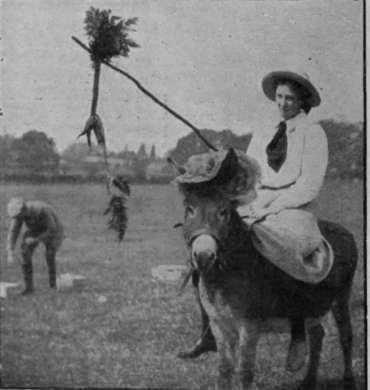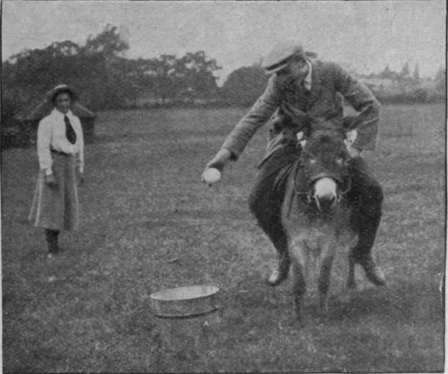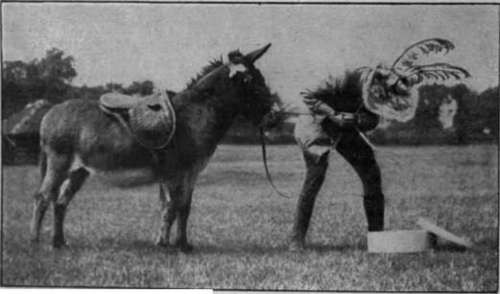A Children's Donkey Gymkhana
Description
This section is from "Every Woman's Encyclopaedia". Also available from Amazon: Every Woman's Encyclopaedia.
A Children's Donkey Gymkhana
A Novel Amusement for the Seaside - The Events of the Gymkhan - The Grand Stand - Needful Accessories - Stick-and-carrot Race - Ball-and-bucket Race - Riding Backwards on a Donkey - The
Comic Hat Race - A Battle of Flowers on Donkey Back
A children's donkey gymkhana affords the greatest possible fun, and at the seaside, where donkeys can be hired for about ninepence an hour, the cost of getting up what will assuredly be voted a "perfectly ripping " party will be comparatively trifling. Certainly it would be hard to find a more novel or exciting way of celebrating an
August or September birthday.
The competitions may be held on the sands, if the place be a sufficiently laded one to admit his without collect-undesirable and uninvited audiences.
or, better still, the of a convenient field may be begged, borrowed) or hired for an afternoon from an obliging farmer, to be turned into a gymkhana ground for the occasion.
Seaside holiday parties are usually impromptu affairs, and in giving one the great thing is to make sure of securing the moving

Stick-and-carrot race. Each competitor tries to incite her steed to its top speed by dangling a fine carro' before its nose spirits of the place, who will be sure to enter into the fun, and make things go with a swing, before inviting the less enterprising boys and girls and smaller children. Those under seven or eight must be bribed into contentedly watching the gymkhana games and competitions with promise of donkey rides after tea.
The oldest variety of seaside clothes that the invited guests possess should be donned for the occasion, for a donkey gymkhana is apt to be a very rough-and-tumble affair indeed. The children, accompanied by parents and guardians, who will thoroughly enjoy looking on at the fun, and will make a most enthusiastic audience, should be asked to arrive punctually by 3.15 p.m.
A couple of grown-up men and girls should be secured, to arrange courses, act as time-keepers and starters, and help generally.

In the ball-and-bucket race each boy catches a polo ball thrown by a girl partnei stationed at a third of the distance down the course
A list of events should be printed on a big board and stuck up where all can consult it beside the grand stand. This latter will probably be contrived from planks held up by flower-pots, with a row of hammock-chairs for the accommodation of older and specially honoured guests, and adorned with flags.
The list of events might run somewhat as follows:
1. Stick-and-carrot race.
2. Ball-and-bucket race.
3. Boy and girl three-legged versus a boy or girl riding backwards on a donkey.
4. Comic hat race.
5. Battle of flowers on donkey-back. The accessories needed for the competitions should be collected together and put in readiness before the guests of the gymkhana arrive. They will comprise half a dozen long, forked hazel switches, and a basket containing a couple of dozen well-scrubbed, luscious-looking carrots with their feathery green tops left on for the purpose of hanging them to the forked sticks, for the stick-and-carrot race; a bucket, half full of water, and a white polo ball (procurable for nine-pence from any sports shop) for each pair of competitors, a boy and a girl for the ball-and-bucket race; half a dozen gentleman's large pocket handkerchiefs for ankle binding for the competitors in the three-legged race; and half a dozen gorgeously decorated hats, each one provided with an elastic or strings by which to fasten it on under the competitor's chin, packed in a cardboard box gaily tied up with coloured ribbons or a strip of satin of brilliant hue, for the comic hat race.
Each hat must be adorned in the wildest travesty of the reigning fashion, and kept as a deep secret, so that it may burst with un-imagined splendour on the eyes of the spectators at the gymkhana.
Tissue paper of every hue will make the blossoms for the battle of flowers. Each blossom should be attached to one of the little burrs which can be collected on any country walk, so that, when the flowers are thrown, the burrs stick, and the flowers remain where they hit, instead of falling down again.
The gymkhana ground should be decorated on the morning of the great day with flags at the entrance gate, and, if possible, at either corner of the field. A lawn-tennis marker will be very useful for marking out long chalk lines for the starting-post and winning-post, and indicating by blobs of white the spots on which the buckets are to be placed for the ball-and-bucket race, and where the girl throwers are to stand.
At either end of the winning-post and starting-post lines plant a flag mounted on a long stick, to make the course as gay as possible.
The donkeys, on arrival, should be decorated with huge paper flowers over either ear, and a gay hat may adorn those steeds willing to wear them.
When the guests arrive, direct the first six competitors for the stick-and-carrot race to go at once behind the starting line and arm themselves with a stick and carrot apiece; they are then to mount their donkeys ready for the first heat, while the audience are being seated.
"One, two, three - Go ! " cries the starter (a lively undergraduate of twenty), waving a white handkerchief in true professional style, and off scuttle the donkeys, their riders urging them on with their rubber-shod heels and with the carrots held temptingly just in front of their noses. Thus urged and encouraged, the donkeys are at last persuaded into a swift canter, and the leader
- ridden by a boy of fifteen - crosses the winning line at a gallop, amidst cheers from the entire field.

The ball safely received, the rider must gallop on and drop it into a bucket of water further along, then ride to the winning-post
When a second race, for children under twelve, has been run, and won by a boyish-looking damsel of eleven, the course is cleared for the next event.
For or the ball-and-bucket race, the buckets are put in a line halfway down the course, and six boys and six girls are invited to come forward and take part in the competition.
Each boy mounts a donkey, and each girl, having been given a polo ball, is directed to stand at a spot marked a third of the way down the course. As the riders are started down the course, each girl makes ready to toss her ball to her partner, who catches it as he rides by, and drops it into the bucket of water a little farther on down the course, before riding on to the winning-post.
Meanwhile, six pairs of boys and girls have had their legs tied together, and are standing about on the outskirts of the field, practising for the next event. The donkeys are arranged behind the starting line, and the riders, each armed with a carrot on a stick, come forward to mount their steeds backwards - by no means an easy feat to perform. At last, they are all up, and the race begins.
Steering a donkey when riding face to tail is an extremely difficult feat, and soon many of the precariously mounted competitors are careering round the field, clinging on wildly for dear life, while one or two couples of three - legged runners have fallen and lie prone upon the ground, too weak with laughter to get up again. The race is finally won by a small boy on d o n k e y -back, who guided his mount with much skill, and easily outdistanced his big pair of three-legged competitors. For the comic hat race, six boy competitors mount donkeys and range themselves in a row behind the starting line, while six huge, gaily beribboned hatboxes are arranged several yards apart on the winning line.
Each competitor must gallop to his special hatbox, dismount, open the box, and don whatever headgear it may chance to contain. Then, remounting his steed, he must travel back to the starting-post as swiftly as may be. Any competitor arriving back at the starting-post without his head-gear is promptly disqualified.

Comic hat race. Each boy must gallop down the course and find the hatbox allotted him, dismount, don the headgear in the box and then ride back to the starting-post. If he arrives hatless, he is disqualified
A comic hat race in full swing is a sight for the gods, for the girl hatmakers will have probably made the most of this matchless opportunity of getting even with teasing brothers and cousins, and paying off old scores. The winner will perhaps come dashing "home" in a jet-covered "charlady's" bonnet, with a long and terrible feather flying in the breeze, while hot on his heels follow the wearers of a baby boy's cotton hat with a lace ruche inside it; a pink muslin sun-bonnet; a matinee hat like a cartwheel, adorned with a huge bunch of barnyard feathers; and a toque made of huge paper roses. Far in the rear, on foot, pulling a stubborn donkey after him, comes a big boy adorned by a pink paper baby hat just like a lampshade. A wild roar of applause greets each hero on his return.
The hostess now comes forward with a huge box of paper flowers; those who can secure steeds mount them, and everyone joins in the battle of flowers until both donkeys and riders are a mass of blossoms.
A loud peal on the gong announces tea, and, after a merry meal, spread picnic fashion out of doors, the smaller children claim the promise of donkey rides made them earlier in the day. The bigger boys and girls now spend a vigorous half-hour in trotting and cantering bevies of laughing babies about the field. Then the gymkhana prizes are awarded, and good-byes are said, and the guests disperse regretfully after what they all pronounce to have been a most exhilarating and delightful afternoon. If it be thought desirable, and there is time when the events have been decided, a pretty and somewhat novel feature may be added to the gymkhana in the shape of a march past of the competitors on their steeds, and,, as a grand finale, the distribution of laurels and prizes to the respective victors by a Queen of Beauty. To avoid any heartburnings, this office may be filled by a baby girl, or by the hostess herself, under the title of Queen of Hearts. Or, again, the Queen may be elected by the guests themselves. She should, of course, be enthroned as suitably as can be managed under the circumstances, and wear a floral wreath and carry a sceptre.
Continue to:


